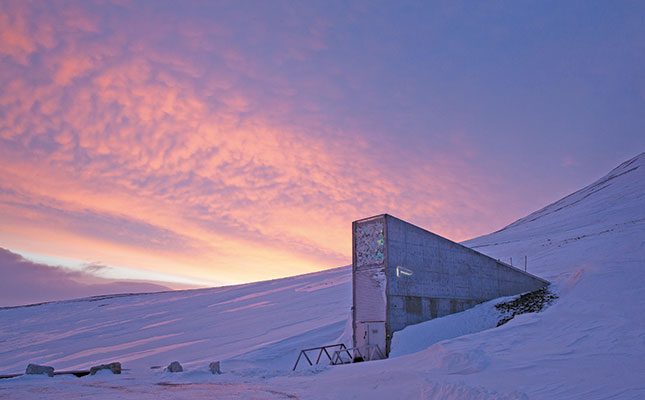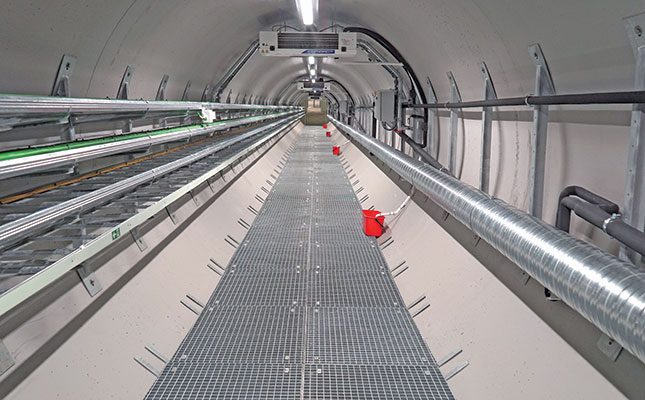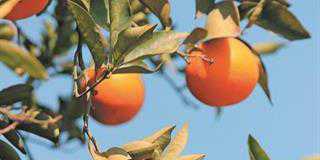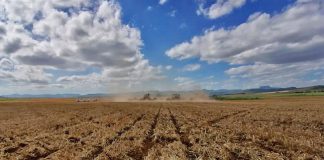
Photo: The Nordic Genetic Resource Center
The Svalbard Global Seed Vault (Svalbard Globale Frøhvelv) holds the key to the world’s crop production. Often referred to as the ‘Doomsday’ vault, the objective of the facility is to safeguard seed for future crop production in the case of a nuclear war or other disasters.
At present, there are over 1,2 million seeds kept at the vault, which is built into a permafrost layer in Svalbard, a Norwegian archipelago.
Gene banks ‘deposit’ duplicates of seeds into the vault to protect against the potential loss of seed due to mismanagement, accidents, sabotage and natural or human-made disasters.
The Seed Vault is managed under terms spelled out in a tripartite agreement between the Norwegian government, the Crop Trust, and the regional gene bank, the Nordic Genetic Resource Center (NordGen). NordGen stresses that the vault is a security back-up, and that depositing gene banks must ensure that they only send the vault duplicates of crop seeds.
The facility was officially opened on 26 February 2008, and was entirely funded and built by Norway. Within the first year, more than 90 000 seed samples had been deposited in the vault, adding to the already over 300 000 Nordic samples that had been stored by NordGen since 1984.

By the end of the first year, the vault had over 400 000 seed samples. In celebration of the Seed Vault’s 10th anniversary in February 2018, 70 000 samples were delivered to the vault, bringing the number of samples received to more than one million.
Importance for food security
According to the Crop Trust, the Seed Vault safeguards duplicates of 1 214 827 seed samples from almost every country, with room for millions more.
“Its purpose is to back up gene bank collections to secure the foundation of [the world’s] future food supply.”
The Crop Trust further says that the Seed Vault is the “ultimate insurance policy” for the world’s food supply. Each seed represents important crop varieties available in the world today. Should a Doomsday event occur, the seed bank aims to ensure that farmers are able to have access to the latest and currently most important seeds for food production.
The Seed Vault also ensures crop diversity, which, according to the Crop Trust, is under constant threat. Threats to crop diversity include extreme weather events, changes in agricultural practices, the emergence and spread of new pests and diseases and human conflict, the Crop Trust says.
“And once an heirloom variety or wild crop relative is lost, it is gone forever.”
According to the Crop Trust, crop diversity is essential for food security and nutrition. “Plant breeders and scientists use crop diversity to develop new, more resilient and productive varieties that consumers want to eat, that are nutritious and tasty, and that are adapted to local preferences, environments and challenges.”
There are more than 1 700 gene banks in the world. However, as the Crop Trust explains, these gene banks are vulnerable to natural catastrophes and war, as well as poor funding or management. The Seed Vault is a backup for these gene banks.
The vault
Svalbard, where the vault is located, is situated in the Arctic Ocean. The three main industries on Svalbard are coal mining, tourism, and research. On 19 June 2006, construction of the vault began when the prime ministers of Norway, Sweden, Finland, Denmark and Iceland laid the vault’s “first stone”.
The vault is located 130m inside a sandstone mountain on Spitsbergen island. This island was considered ideal because it lacked tectonic activity and had permafrost, which aids in the preservation of the seed, according to various sources.
It is also around 130m above sea level, which ensures that the facility will be kept dry, even in the event of the ice caps melting. NordGen manages the facility, but there are no permanent staff on site. According to the company, staff are sent to the vault when it is opened for deposits. Nordgen is also responsible for servicing and for continuous surveillance of the vault.
Locally mined coal provides power for the vault’s refrigeration units. All seeds need to be kept at -18°C. The permafrost and sandstone in which the vault has been built assures that even should the refrigeration units fail, it would take weeks for the vault to reach the average ambient temperature of -3°C. According to some sources, it would take up to two centuries for the vault to warm to 0°C.
Prior to construction, a feasibility study was conducted, which found that the vault could preserve most major crops’ seeds for hundreds of years. Seeds are sealed in custom-made three-ply foil packages, which are sealed inside boxes and stored on shelves inside the Seed Vault. The low temperature and moisture levels inside the Seed Vault ensure low metabolic activity, keeping the seeds viable for long periods of time.
Perpetual Repercussion, an artwork by the Norwegian artist Dyveke Sanne, runs the length of the facility’s roof and down the front face to the entryway, which marks the location of the vault from a distance. The roof and vault entrance are filled with highly reflective stainless steel, mirrors, and prisms. The installation reflects polar light in the summer months, while in the winter, a network of 200 fibre-optic cables gives the piece a muted greenish-turquoise and white light.
The vault is large enough to store over four million crop seeds. In 2019, the seed vault cost about Kr2,4 million (about R4 million) a year to maintain. The Norwegian government entirely funded the vault’s construction, which cost around Kr45 million (about R79 million) in 2008. The operational costs of the vault is paid for by Norway and the Crop Trust.
Visit NordGen.org.










